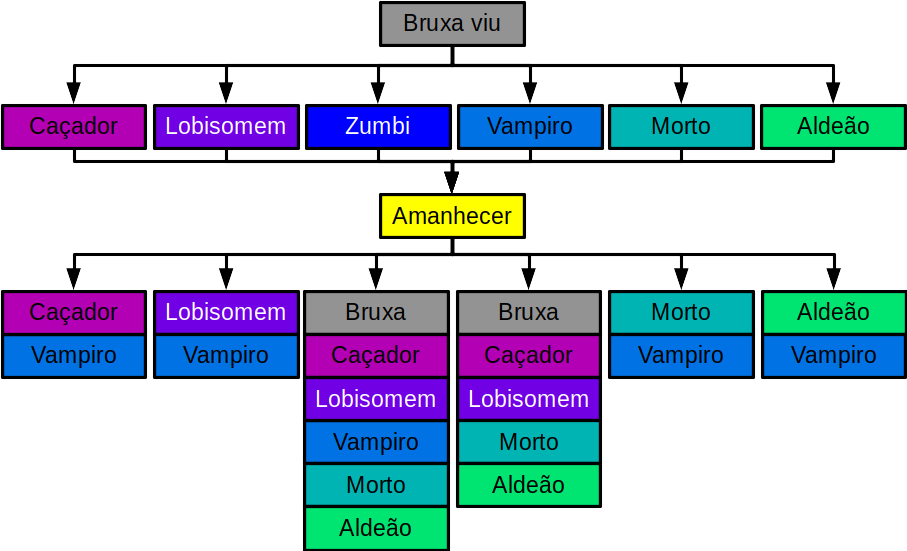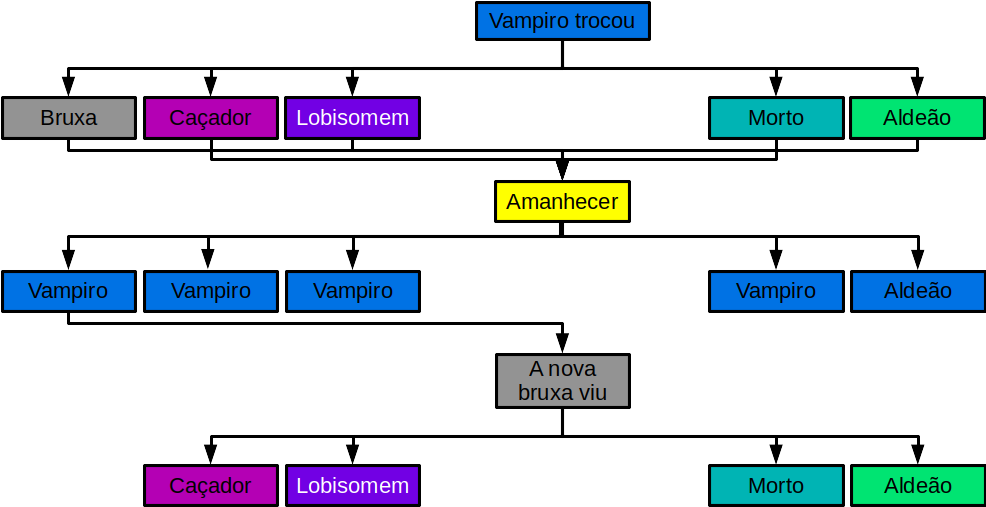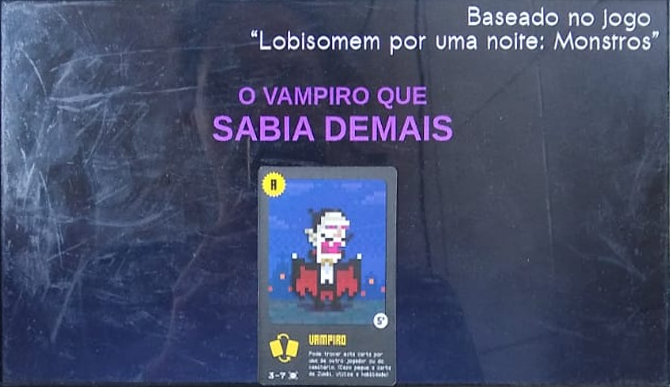The Vampire Who Knew Too Much
“You don’t know anything, Witch” – said the Vampire
The game “Werewolf for a night: monsters” is a variation of the popular game “Werewolf” (we have already covered this game in the post Siege of the last Beast of Gévaudan). In it we have characters with specific powers and actions that are performed in the same order that we will present:
- Hunter (Villagers team): hides without looking, one of the 3 cards in the graveyard
- Witch (Villagers team): sees another player’s role at the table
- Werewolf (Werewolves team): see the cards in the graveyard
- Zombie (no team): hides your original card and takes one of the cards from the graveyard, if you have any power, you can use it
- Vampire (Villagers team): exchange your card for any other card on the table (from the players or from the graveyard), if you have any power, you can use it.
After the actions, a debate begins to find out who the Werewolf is, there are also characters from Dead (Dead team) and Villagers (Villagers team), both without powers. The number of Villagers and Dead cards varies according to the number of players, between 3 and 7 (not counting the Storyteller).
At first, it may seem that the Witch knows a lot, as she knows the identity of one of the players at the table and is the second player (thus, she knows if there is a Hunter in the group, as she will be missing a card in the graveyard). But what if I say that the Vampire may know much more than the Witch?
The Witch’s scrying problem stems from the moment she plays.
- if she saw that someone is the Zombie, then by dawn this player will have exchanged his identity for one of the cards in the graveyard.
- if she saw that someone is the Vampire, then by dawn this player must have changed his identity for one of the cards on the table (either from the graveyard or from the players).
- If she has seen a Vampire and at dawn she has the Vampire card, then she surely knows who the current Witch is.
- if she’s seen a different character, if there’s a Vampire among the players (or a Zombie takes over a Vampire’s body in the graveyard), the character may have changed her identity.
To simplify (maybe simplify isn’t the best word for it), I’ve organized from what the Witch saw of a player’s hand, who he could be until dawn. It is interesting to note that if the Witch has seen a Hunter or a Villager, she can be sure to trust both of them after dawn, as they can at most have switched to Vampires (also from the Villagers team). On the other hand, if the Witch has seen a Werewolf, it is not possible to be sure that he will remain a Werewolf at dawn (it could be a Vampire). And the worst of the situations involves her seeing a Zombie or a Vampire, because in that case, she will be sure that by dawn they will no longer be who she saw (except for her seeing a Vampire and herself dawning as a Vampire, in this case, will know that the former Vampire is now the current Witch, who is on the Villagers team, so you can trust).

While the Witch only sees what the other player has in their hands, the Vampire exchanges her card for a card on the table (it can be from the graveyard or another player’s card). So, if the Vampire exchanged the card with any of the players at the table, he will know exactly what the player had and what he has now (which will be the Vampire card).
In the event that he exchanged the card with someone who had the Witch, the former Vampire will be able to use his power to see the identity of another player (as the former Witch he already knows will be the current Vampire). To simplify how this information changes, I organize the events of the Vampire’s action in the diagram below.

In order to determine how certain the Witch is, we’ll need to define some game conditions. Let’s say we are 7 players without considering the Storyteller, in which case we have 1 Hunter, 1 Witch, 2 Werewolves, 1 Zombie, 1 Vampire, 2 Dead and 2 Villagers. Of these 10 cards, 7 are dealt to the players and 3 are in the middle of the table (graveyard).
The Witch then wakes up, sees that the 3 cards are in the graveyard and sees a Werewolf in the hand of one of the players, then goes back to sleep. The next morning the 3 cards are still in the graveyard and she is still the Witch. So she thinks: how likely is the player she saw to still be the Werewolf?
The fact that the 3 cards remain in the graveyard, indicates that both the hunter and the zombie are in the graveyard.
The probability of initially having a Vampire among the players is 5/6, as we have 5 players with unknown roles and 1 unknown card in the graveyard.
Suppose the Vampire’s decision was random, i.e. he swapped his card for any player’s card or the graveyard, but as there are still 3 cards in the graveyard, so he couldn’t have taken on the role of Hunter or Zombie, and he didn’t take on either. the role of Witch. So the chance that he swapped his card with one of the other 5 players is 5/6.
In this way we have:
- Chance of Vampire being initially in the graveyard: 1/6
- Chance of Vampire swapping places with a card in the Graveyard: (5/6)*(1/6) = 5/36
- Chance of the Vampire switching places with a different player than the Witch saw: (5/6)*(4/6) = 20/36
- Chance that the Vampire switched places with the player the Witch saw: (5/6)*(1/6) = 5/36
That is, at dawn the Witch is 86% (1 – 5/36) sure that the player she saw playing the Werewolf role is still the Werewolf.
So while the Witch may think she knows the identity of someone in the game, there is a margin of uncertainty that can get her into trouble during the debate. Something that certainly doesn’t happen with the information the Vampire carries, as the identity of the player he swapped with will remain at dawn (that is, it will undoubtedly be the new Vampire).

